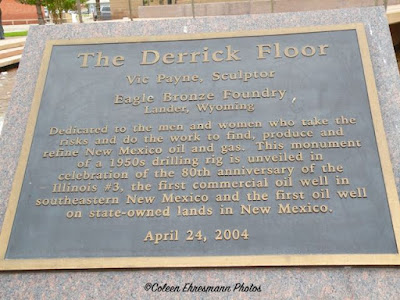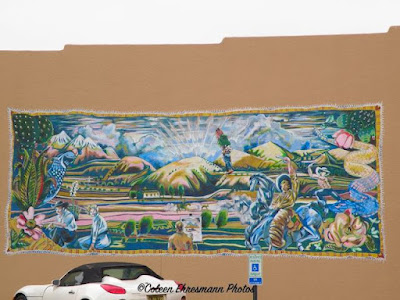When we stopped in Artesia NM April 13, 2010, Hubby and I were driving north on Hwy 285 from Carlsbad. We stopped long enough to find something to eat and then continue north to Roswell, our next destination.
This is the first site of the community. An oil refinery. We were somewhat surprised as we had not seen many oil wells along the road. Why a refinery?
railroad tracks filled with oil tank cars
Well, the reason for that large refinery was explained today as we traveled about 60 miles from Lovington to Artesia on Hwy 82. Half that distance is through the sand hills of southeastern NM, the Loco Hills. For 30 miles pumpjacks dotted the landscape as far as the eye could see. Some of the wells were pumping and others were at rest. White pick-up trucks traveled about on the sandy roads between the pumpjacks and the storage tanks. It was a site we have never seen before. So awed was I, I never thought to pull out the camera and take a photo!

So now we understand the reason for the site that greets travelers from the south and the east. Our stop in Artesia today was for lunch and geocaching. And because of geocaching we explored more areas of the thriving community, built on ranching and oil. We explored numerous sculptures around town that told the history of the region.
Three amazing sculptures were part of The Derrick Floor, telling the story of oil in this region.
It was such a dreary, cloudy day any sculpture photos did not turn out very well. This is the derrick floor sculpture.
This was my favorite piece of the three.
"Woman's Intuition" depicts Mary Yates sitting on a spool of cable, pointing to a spot on the ground. Her husband had drilled two dry wells, and the Yates' hired geologist refused to pick another. So Mary chose a spot and said, "Drill there." Her husband did, and struck oil on April 9, 1924, ushering in the Artesia oil boom.
The second sculpture, "Derrick Floor," is a full-size 37-foot-high drilling rig created by artist Vic Payne. Visitors are welcome to climb onto the drilling platform and examine the sculpture's obsessive technical detail. According to its plaque, the sculpture is meant to ennoble the workers "who take the risks and do the work to find, produce, and refine New Mexico oil and gas" -- so its four-man crew is scaled at a hero-size 125 percent.
"Partners" shows big-bellied oilmen Mack Chase and Johnny Gray leaning across the artfully floating hood of a pickup. The two local men went into the oil and gas business in 1972, and for 20 years ran a successful company making most of their business deals this way: no lawyers, and just a sun-baked truck hood desk.
one of several colorful murals along Main Street
Sallie was the niece of cattle baron, John Simpson Chisum. She came to NM from TX with her father and two brothers after the death of her mother and sister. Sallie was 19 years old. She became the hostess for Chisum ranch, South Spring, northeast of Roswell. Her uncle John had made a name for himself, the "Cattle King." She was a competent hostess, horsewoman, businesswoman, entrepreneur, realtor, and the first postmistress of Artesia.
Sallie was married and divorced twice. She and her first husband had two sons who were sent to boarding schools in KS and Germany. She did not have any children with her second husband who had a ranch near Stegman. When artesian water was discovered on their land, the town was renamed Artesia.
According to her diaries, She and William Bonny were good friends. But then, it is said, Sallie was loved by every cowboy within miles of Roswell. Sallie lived in Artesia after her second marriage, building a home that was a safe haven for orphans and abandoned women. She sounds like quite the woman and deserving of the honor bestowed on her.
the sculpture at the library round-about
Trail Boss
This is one of 3 ranching sculptures in Artesia. They tell the story of the Vaqueros who rode with the cattle and protected them from predators and Rustlers. This photo is from this trip.
April 13, 2010
same gas station, same sculpture from the opposite direction

















It wonderful where our travels take us unexpectedly. Nice history.
ReplyDelete